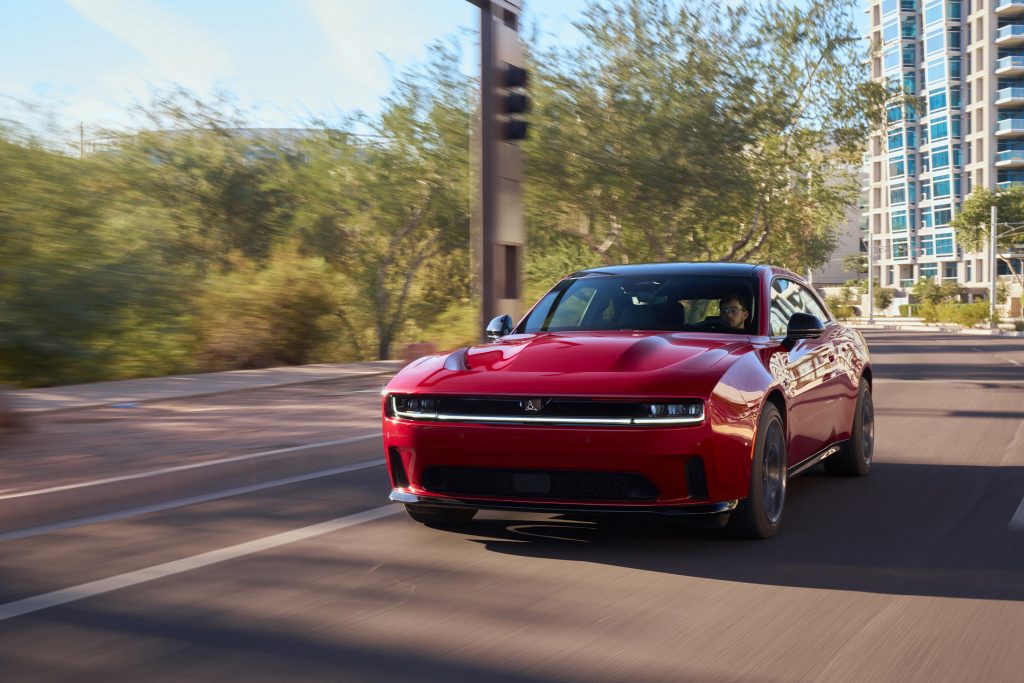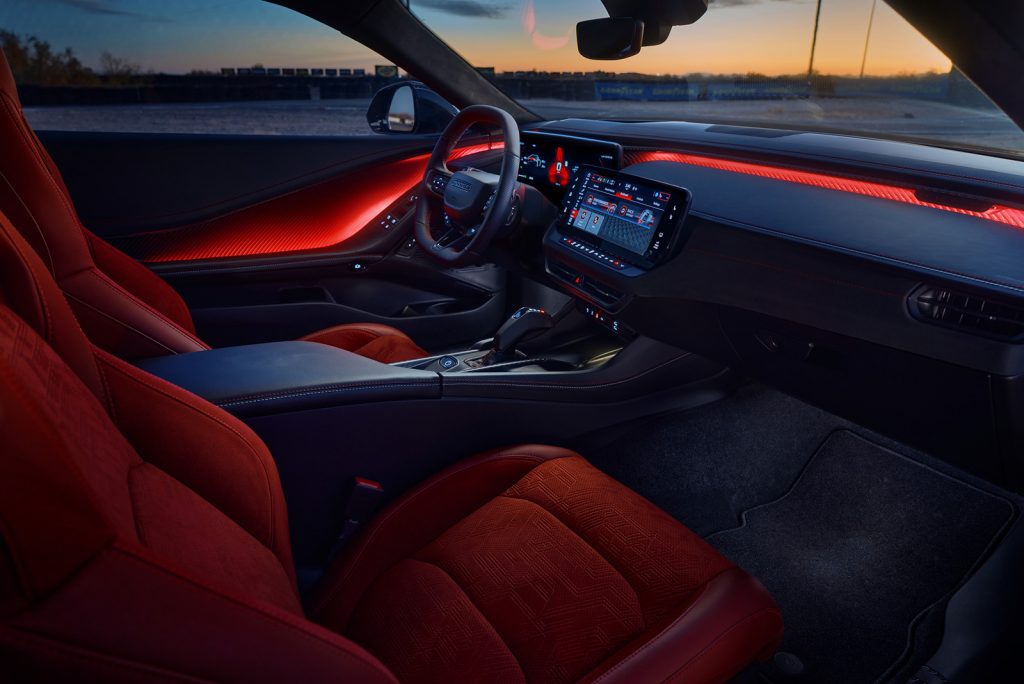Cargazing
By Derek Price
Dodge has never been a brand for the faint of heart. From the Hellcat to the Demon, their recent gas-powered muscle cars have celebrated excess, noise and spectacle.
Now, with the Charger Daytona, Dodge is venturing boldly into electric territory while bringing along all the attitude that defined its combustion-powered predecessors.
The Charger Daytona represents something genuinely novel: the world’s first electric muscle car. And unlike many EVs that seem determined to highlight their environmental credentials through minimalist design and silent operation, the Charger proudly maintains its muscle car identity.
Visually, the Daytona R/T strikes a perfect balance between retro inspiration and forward-thinking design.
Its silhouette clearly references the brand’s heritage, but Dodge has cleverly incorporated elements only possible with an electric platform. The front R-Wing, a functional aerodynamic pass-through that allows air to flow through the nose of the car, creates a distinctive visual signature while enhancing downforce.
This marriage of past and future extends throughout the design, from the full-width LED light bars front and rear to the muscular body sculpting
Inside, the cabin focuses squarely on the driver with a cockpit-like layout. The heated flat-top/flat-bottom steering wheel, center console-mounted pistol-grip shifter and high-backed seats all reinforce the performance-oriented character.

The Dodge Charger Daytona R/T features the innovative R-Wing front design that allows air to pass through the nose of the car, combining retro muscle car styling with functional aerodynamic benefits.
But what truly sets the Charger Daytona apart from every other EV is the controversial Fratzonic Chambered Exhaust.
This system uses passive resonators to create a soundtrack that mimics a traditional high-performance V8. The result is remarkably convincing, especially in the higher-performance Scat Pack models where the volume rivals Dodge’s old supercharged Hellcat engines.
The R/T model I tested produced a slightly less intense but still deeply satisfying rumble that you can actually feel in your chest. It’s certainly artificial — there’s no actual exhaust, after all — but the system succeeds in maintaining a crucial part of the muscle car experience that other EVs abandon. The sound increases in intensity with acceleration, providing auditory feedback that most EVs lack entirely.
Performance is exactly what you’d expect from a Dodge wearing the Daytona badge.
The instant torque delivery results in violent acceleration when you mash the throttle, while the PowerShot button on the steering wheel unleashes an additional 40 horsepower for 10 seconds at a time.
This combination makes the Charger feel properly quick, though it can’t match the outrageous thrust of the outgoing Hellcat models.

With its driver-focused cockpit, flat-bottom steering wheel and customizable Attitude Adjustment ambient lighting system, the Charger’s interior provides a thoroughly modern interpretation of classic muscle car design cues.
The Charger’s 100.5 kWh battery pack gives an EPA-estimated range of 268 miles — adequate but not exceptional by current EV standards.
Of course, all EVs face the same practical limitations, and the Charger is no exception. While perfect for daily commuting or weekend fun, long road trips require planning around charging infrastructure.
For now, the Charger works best as either a local commuter or a second vehicle for enthusiasts.
At $70,970 as tested, the Charger Daytona R/T isn’t inexpensive. But considering the technology on board and the performance it delivers, it’s reasonably priced among high-performance EVs.
The higher-output Daytona Scat Pack, with its 670 horsepower, starts at $69,995.
Whether traditional Dodge enthusiasts will embrace this new direction remains an open question. The brand has certainly made a sincere effort to preserve the character and spirit of its muscle car heritage while adapting to an electrified future.
The Charger Daytona offers performance, theatrical presentation and unapologetic attitude—hallmarks of the brand regardless of what’s powering the wheels.
At A Glance
WHAT WAS TESTED?
2024 Dodge Charger Dayton R/T Plus ($57,995). Options: Premium paint ($795), R/T Stage 1 ($1,600), Plus Group ($4,995), blacktop package ($1,095), sun and sound package ($2,495). Price as tested (including $1,995 destination charge): $70,970
BY THE NUMBERS
Wheelbase: 121 in.
Length: 206.6 in.
Width: 79.8 in.
Height: 58.9 in.
Power: Dual 400-volt electric motors and 100.5 kWh battery (496 combined hp)
Range: 268 miles
MPGe: 90 city, 79 highway
RATINGS
Style: 9
Performance: 9
Price: 5
Handling: 7
Ride: 7
Comfort: 7
Quality: 7
Overall: 8
WHY BUY IT?
The Charger Daytona successfully translates muscle car attitude to an electric platform, combining head-turning retro-modern styling with exhilarating performance.
